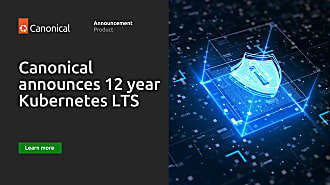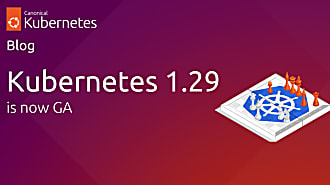Yalton Ruiz
on 12 April 2023
Canonical Kubernetes 1.27 announcement

Canonical Kubernetes 1.27 is now generally available
Following the release of upstream Kubernetes on 11th of April, Canonical Kubernetes 1.27 is generally available in the form of MicroK8s, with Charmed Kubernetes expected to follow shortly.
We consistently follow the upstream release cadence to provide our users and customers with the latest improvements and fixes, together with security maintenance and enterprise support for Kubernetes on Ubuntu. This blog is a quick overview of the latest development highlights available in Canonical Kubernetes 1.27.
What’s new in Canonical Kubernetes 1.27
All upstream Kubernetes 1.27 features are available in Canonical Kubernetes for both its distributions, MicroK8s and Charmed Kubernetes. The following highlights are new in Canonical Kubernetes 1.27.
MicroK8s 1.27 highlights
MicroK8s upgrades on Cluster API
MicroK8s continues expanding support for ClusterAPI (CAPI) in this release, implementing and verifying two types of MicroK8s upgrades managed by ClusterAPI. Both in-place upgrades, for those clusters with no High Availability (HA) by upgrading the nodes without halting them, and rolling upgrades for HA clusters are now available.
This functionality will ensure that all MicroK8s clusters deployed with CAPI have secure lifecycle management and access to latest releases and features.
MicroK8s AWS appliance launched
MicroK8s is now available from the AWS Marketplace as an appliance. This makes it possible to deploy a Kubernetes cluster in 10 minutes, with a user friendly interface and all the advantages of MicroK8s on AWS:
- CNCF conformant Kubernetes cluster
- Rich set of commonly used Kubernetes addons you can enable on-demand
- Automated updates so your cluster is always up-to-date
- High availability for your workloads and the cluster
For more information please https://canonical.com/blog/microk8s-is-now-on-aws-marketplace
MicroK8s EKS-D updates
In the 1.26 release, MicroK8s launched Amazon Elastic Kubernetes Service (EKS-D) integration, supporting EKS-D tracks and enabling users to use MicroK8s based on EKS-D with on prem deployments. With release 1.27, MicroK8s also releases the latest EKS-D (version 1.25), available through the 1.25-eksd channel.
Launch configuration
Cluster provisioning for MicroK8s is now easier and faster than ever with the ability to fully customise and configure each node in advance of deploying it. This new feature (think of it as ‘microk8s init’) enables the specification of any of the supported addons and key configuration parameters to make repeatable, fast deployments of fine-tuned MicroK8s nodes as easy as running `snap install microk8s – – classic`. This much-requested feature is available right now with full documentation covering its use and a guide to the configuration options.
NVIDIA MIG support
The processing of big data and AI requires GPU-acceleration to transfer heavy workloads from the CPU to the GPU where they can be more efficiently processed. Multi Instance GPU(MIG) is an enhancement of the processing capabilities allocation, it expands the performance and value of the NVIDIA H100, A100 and A30 Tensor Core GPUs by partitioning the GPU into as many as seven instances, each fully hardware isolated with its own high-bandwidth memory, cache, and compute cores.
The partitioned instances are transparent to workloads, which greatly optimizes the use of resources and allows for serving workloads with a guaranteed QoS . The MicroK8s ‘gpu’ addon provides seamless support for MIG with only a few configuration steps. For more information see the MIG documentation.
The addon community expands with new partnerships
Our commitment to support the wider MicroK8s community in creating addons – extra services which can easily be added to MicroK8s – has resulted in three exciting new partnerships for this release:
- Shifu: The partnership with Shifu takes IoT and Edge development to another level, using the Shifu framework, developers can more easily connect, monitor and control any IoT device.
- EasyHAProxy: Automatically configure HA proxy as an ingress based on container labels.
- Parking: Parking addon deploys a static webserver to park a domain, including setting up all necessary ingress, service and pods.
You can find the full list of available addons in the MicroK8s documentation.
MicroK8s 1.27 is generally available now. For the full list of changes and features, please see the MicroK8s release notes.
Charmed Kubernetes 1.27 highlights
Cilium CNI
We are excited to announce the inclusion of Cilium in our portfolio of Container Network Interface solutions for Charmed Kubernetes. Cilium is a powerful CNI, network security and observability solution which provides enhanced performance and improved security for containerised applications. The current version of Cilium shipped within the charm is 1.12.5. It also comes bundled with Hubble: a networking and security observability solution that offers real time insights of the network and the security state of the cluster with little performance impact.
Cloud Providers and Cloud Storage
Operator charms for external cloud providers have been expanded and now include AWS, Azure, GCP, and vSphere. Previously, cloud-specific features such as load balancing and storage were managed by Kubernetes in-tree solutions. Today, cloud provider charms offer flexible management of these features decoupled from any specific Kubernetes release.
NVIDIA Network Operator
The NVIDIA network operator charm is a new addition to the Charmed Kubernetes ecosystem. It leverages components such as SR-IOV and the Multus CNI to simplify the deployment, operation, and management of NVIDIA networking for Kubernetes.
KubeVirt
Offered as a technical preview, the KubeVirt charm offers an opinionated deployment of KubeVirt on Charmed Kubernetes such that virtual machines can be launched within your Kubernetes cluster. Charmed Kubernetes on metal will deploy KubeVirt in such a way to use faster, native hardware virtualization, but KubeVirt also supports software emulation for cases where accelerated hardware support is not available.
Volcano Scheduler
Offered as a technical preview, the suite of Volcano charms deploys on either MicroK8s or Charmed Kubernetes, and can be used to more effectively schedule ML/AI workloads which need to ensure effective queuing of jobs requiring GPU resources. The charm ships with v1.7.0 of Volcano and will follow future upstream releases.
Cluster API Providers
Cluster API providers for deploying Charmed Kubernetes are nearing completion and available as technical previews. These providers consist of the Juju Infrastructure Provider, the CharmedK8s Control Plane Provider, and the CharmedK8s Bootstrap Provider.
The infrastructure provider is responsible for Juju model management and machine deployment. The control plane provider handles control plane management, kubeconfig management, and control plane status reporting. The bootstrap provider controls what charms are deployed to the machines provisioned by the infrastructure provider.
While the user experience surrounding certain Juju-related interactions is still being improved, Charmed Kubernetes can be deployed using the familiar Cluster API workflow using the providers in their current state.
Changelog for upstream Kubernetes 1.27
You can read the changelog for full defaults regarding features, deprecations and bug fixes included in 1.27.
Learn more about Canonical Kubernetes or talk to our team
- ubuntu.com/kubernetes
- microk8s.io
- #canonical-kubernetes and #microk8s on the Kubernetes Slack
- Discourse
- Twitter – @canonical, @ubuntu



